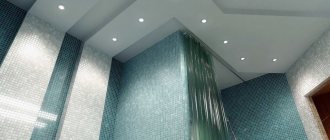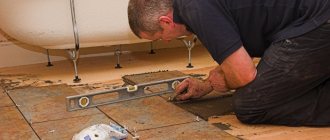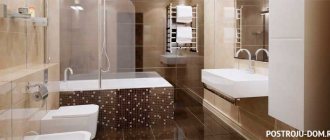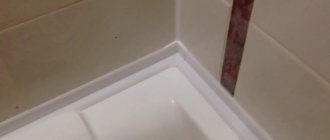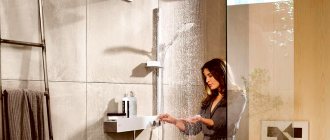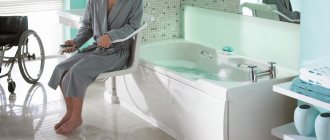Purpose
A niche is an architectural element that is a recess in the wall. Niches have been used in the interior of residential premises for a very long time - since the times of Ancient Greece and Ancient Rome. Initially, this structural element decorated the walls of temples and served to store religious objects, for example, statues of pagan gods and other relics. Later, niches appeared in the walls of palaces. In rich houses, valuables and works of art were placed in niches - vases, figurines, etc.
In a modern interior, the purpose of a niche is more practical. Increasingly, when designing housing, certain functions are assigned to a niche in the wall. So, it can serve as a kind of cabinet for storing household items. When it comes to the interior of a bathroom, a wall niche is usually used for towels, hygiene items, household chemicals, toilet paper, etc. If you carefully consider the placement of niches in the room, you can get a universal storage system and, thus, do without cabinets, chests of drawers and shelves that clutter up the bathroom.
In addition to its main purpose, a niche in the wall can be used to organize spot lighting, since it is convenient to install built-in lamps in it.
What should you consider before creating a niche?
Before you begin calculations and installation of the shelf, you need to focus on several important points.
- Be sure to consider the humidity in the room. For example, if the shelf is intended for the bathroom, then it would be more rational to give preference to the moisture-resistant version of the plasterboard.
- If you set out to make shelves in the pantry as a place to store household utensils, then keep in mind that they must withstand increased loads. As reinforcement, you can use two guide profiles, then the thickness will become greater, but it will be able to withstand more severe loads. Another small point - the greater the load expected, the smaller the pitch between the screws to be screwed in should be.
- Drywall shelves are often complemented with lighting. This not only adds a unique touch to the interior, but in some cases also increases functionality - they serve as an additional source of light. All work on the installation of wiring and lighting equipment is carried out before covering the structure. It is also better to make holes for spotlights in the blanks in advance.
You can only make durable shelves that will delight you for many years if you take these small details into account.
pros
- The main function of a wall niche is to store all kinds of things. Depending on the size and location, it can be used as a rack or shelf. But, unlike these pieces of furniture, a niche in the wall looks quite fresh and original, reminiscent of the style of antiquity and classicism.
- A niche allows you to make good use of space that usually remains unused: for example, above the bathtub or above the toilet. If the room has built-in plumbing equipment, all connections to which are hidden behind a plasterboard wall, a wall niche will be an excellent solution that saves space in a small bathroom.
- If there are a large number of communications on the walls in the bathroom that spoil the appearance of the room, this problem can be easily dealt with by hiding everything behind a false plasterboard wall. And so that useful space does not go to waste, one or more niches should be organized in the wall. Even if you don't need additional storage space, niches can be used for interior decoration, such as placing candles or potted plants in them.
Related article: How to install a door frame yourself? (video)
How to choose the material for bathroom shelves
You must select the material solely to suit your taste.
It is important to consider moisture resistance, strength and the number of items that will be located on the shelves
The closer the shelf is located to the water source, the more moisture resistant the material for its manufacture should be.
Glass shelves
Glass has excellent performance characteristics and visually makes the room wider. This is a very thin and fragile material that must be used wisely: it may not withstand heavy loads on the base. Glass models require additional care, careful and careful handling. There are a lot of designs of such structures, so everyone can choose something for themselves. The combination of glass with chrome surfaces and a wooden frame looks great.
Illuminated glass shelves look especially attractive and can become the highlight of a bathroom interior.
Bathroom shelf made of PVC pipes
Plastic products are easy to use and easy to maintain. They can be painted as you wish and given any shape. But it is worth remembering that plastic loses its original shape over time. Despite this disadvantage, such products are very popular among buyers. When choosing, you need to take into account several details: the manufacturing company and quality, since plastic does not always have a good cost-quality ratio. A good option is shelves with small holes that allow excess liquid to drain.
You can make such a shelf from PVC pipes with your own hands
Metal shelves
Embedding a metal shelf is an ideal solution, as it has an excellent aesthetic appearance, is characterized by wear resistance and good technical characteristics. The only drawback: metal products corrode over time and a limescale deposit forms on them. In addition, the shelves are much more expensive than plastic or other similar models
They are a little more difficult to care for, which is also important
Chrome bathroom shelf in modern style
Experts recommend buying metal shelves with a chrome coating - a special composition will help avoid the appearance of plaque, rye, and maintain the appearance in perfect condition.
Choose chrome shelves for a high-tech style bathroom. If the shelf is forged, it will look great in the Provence or Country style.
Hanging shelf on a metal frame with wooden drawers for a retro-style bathroom
Wooden shelves
Wood is an environmentally friendly material that fits perfectly into different styles. It is pre-treated, making it resistant to moisture, and varnished. This shelf will look harmonious in any bathroom.
Wooden shelves will be appreciated by lovers of comfort and adherents of natural materials.
Velcro shelves
There is a good and budget alternative to expensive designs - shelves with suction cups. They are suitable for any room and can be of different shapes. They are easy to install and dismantle, remove for maintenance (washing) and move to another corner of the room.
Shelves with suction cups are designed for small things - sponges, brushes, small bottles and vials
There are metal corner or non-corner shelves with Velcro, plastic is used. Depending on your needs, you can choose multi-tiered or single-tiered; the total number varies from 1 to 6 levels. Focus on the size of the bathroom - perhaps 1 or 2 tiers are enough.
Glass and ceramics
The ceramic product looks neat and expensive, is easy to care for and easy to install.
Ceramic toothbrush rack with towel rack
Finding your ideal shelf is not difficult: the modern market offers a lot of variations for any interior solution. Focus on its purpose: compact and convenient arrangement of all the necessary little things, household chemicals and cosmetics.
Minuses
- For inexperienced craftsmen, arranging a niche in the wall can turn into a real challenge. To do this, in general, is not so difficult, but for this you will have to make some calculations correctly. In addition, you will need to go to a hardware store to purchase the necessary materials and tools. However, if you don’t have the time or desire to bother with repairs, you can always entrust the construction of a niche to a professional - an experienced craftsman can easily cope with such a task.
- Compared to traditional bathroom storage solutions, wall niches have limited functionality. Firstly, they do not protect things from dust and water splashes. Secondly, niches can rarely be made deep enough to accommodate large items. And finally, things in niches always remain in sight, so storing personal hygiene items in them is extremely inconvenient.
- Another disadvantage of a niche in the wall is that if you want to get rid of this architectural element, you will have to carry out dismantling work. Therefore, when planning a niche in the bathroom, you need to be sure that in the next few years you will not want to get rid of it.
Why do we need niches in the bathroom?
This architectural element is an excellent decoration, and in addition, hygiene products and bath accessories are stored here. Niches are installed both above the washbasin and in the wall above the bathtub. Pots with plants, figurines, beautiful vessels, and candlesticks placed in these places look stylish. A mirror in a niche placed opposite the doors will make the room visually wider and the niche itself deeper.
According to the design, there are niches both horizontal and vertical. It is better to place the first ones on a narrow wall; they will visually lengthen it. On a long wall, openings located vertically look good, especially when equipped with decorative light.
The configuration of the niches depends on the imagination and capabilities of the owner, but must necessarily correspond to the general style. Thus, the marine interior corresponds to round openings reminiscent of ship's portholes with mounted photographs depicting the underwater world. An aquarium installed in a niche will be in complete harmony with this style. High-tech or modern correspond to niches with strict geometric shapes. Arched recesses are suitable for a classic style.
How to make from drywall?
As we said above, making a niche out of plasterboard with your own hands is quite easy, so if you have at least minimal construction experience, you can safely get down to business.
Let's consider the stages of work on the manufacture of such a niche.
Material selection
Since we are talking about a bathroom, the drywall must be moisture resistant. It is easily recognized by its special blue or green coating. This type of drywall resists moisture, so it does not exhibit mold or signs of rotting. In addition, you need to purchase a metal profile, which will be used to construct the frame of the structure. The profile should be of two types - guide and rack.
Preparing tools
Depending on the material of the walls in the bathroom, you will need dowel nails or self-tapping screws. Self-tapping screws of a different size must be purchased for covering the profile with sheets of plasterboard. In addition, prepare a screwdriver, a cutter for working on drywall, a drill or hammer drill, a hammer, a tape measure, an angle ruler, a building level and scissors for working with metal.
Related article: Design of a walk-through living room, living room combined with hallway
Create a drawing
You don't need any special drawing skills. Just draw a sketch, carefully measure everything and once again make a drawing of the future structure, indicating all the dimensions.
Preparatory work
First of all, you need to prepare your work surface. The section of the wall on which the niche will be located should be freed from remnants of building materials and dirt. Then, armed with a building level and a tape measure, draw markings on the wall for fasteners and guides. If desired, use a laser level - it will help you make everything perfect.
Frame construction
In accordance with the markings, you need to fix the guide profile to the wall. Make sure that the guides do not deviate, otherwise the structure will bend. The profile is attached to the wall using screws or dowels. Then, a rack profile is installed into the guide profile in increments of no more than 60 cm. The smaller the distance between the sections of the rack profile, the more durable the final structure will be.
Communications liner
If the wall niche will serve, among other things, to hide pipes or wires, then after assembling the frame you need to take care of communications, since at the next stage access to them will be closed.
Sheathing with plasterboard
Once the frame is completed, most of the work is left behind. Using a pencil or marker, a kind of “pattern” is applied to the sheets of drywall, according to which the necessary parts are cut out with a sharp cutter. Then we attach the parts to the metal profile with self-tapping screws. The optimal distance between the screws is 10-15 cm. Carefully join the sheets at the corners to make the structure look presentable.
In the following photos you can see the entire sequence of the process.
Installation of the supporting structure, taking into account shelves and niches
Installation work in the bathroom is carried out with markings. First of all, using a dye cord, markings are applied to the floor. The lines are made clearly and accurately along which guide profiles (PPN) will be mounted. Next, the same line is exactly copied onto the ceiling covering. To carry out this procedure correctly, it is best to use a suspension. It is best to install guide profiles in the bathroom with an assistant. One person holds the guide profiles strictly along the intended line, and the second drills holes in them for the dowels. The pitch between the holes should be from 60 to 100 cm. There are 3 to 5 or more dowel nails per guide profile, but no less, for the sake of structural reliability. Today, built-in niches and various decorative plasterboard shelves in the wall plane are often used. Niches are also used to hide various pipes and communications. It is recommended to first draw a drawing with the appropriate dimensions. A built-in niche, regardless of size, also begins with the installation of guide profiles that will create the perimeter of the shelf itself. Similarly, for the niche, holes are made in the PPN for dowel-nails. Then, after the work has been completed, it is necessary to re-mark the vertical PP profiles and the exact locations for the fasteners. The distance between the vertical profiles will be determined by the moisture-resistant drywall (the width of the sheet itself). Usually the distance ranges from 40 to 60 cm. After all the marked work and holes, using dowel-nails and screws, straight plumb lines are attached. At the same time, a frame partition is installed where the built-in niche will be located. It is logical that the distance from the base wall will be equal to the depth of the shelf. Partitions are made from the same profiles (PNP), then the base wall with the frame is attached using special jumpers.
Design and decoration
There are endless options for designing a wall niche. If you prefer that this element does not stand out, you need to make it in the same colors or using the same finishing materials as the entire bathroom. If your goal is to draw attention to a niche, you can highlight it with the help of contrasting colors and textured material. Experts do not advise making dark niches on a light background, as this creates the effect of holes in the walls.
Related article: How to decorate the walls in the kitchen - the best options
You can draw attention to objects located in a niche by organizing lighting - LED strip or built-in spotlights.
When thinking about the appearance of a niche, you need to take into account many important points - its size, shape and depth. The niche can be rectangular or with a rounded top, reminiscent of an arched vault. Sometimes it makes more sense to make two narrow niches instead of one wide one. The space in long niches can be divided using transparent glass shelves - it looks very impressive.
Bathroom with niche
In some bathrooms, a niche is provided in the original layout. In this case, it is important to use this element most rationally. In a large niche are placed:
- heated towel rail;
- washing machine;
- boiler;
- a cabinet to hang robes;
- shower stall.
The free space is decorated in the same style as the bathroom, with shelves at the top.
Adviсe
- If the niche is located in close proximity to a water source, for example, above a bathtub or inside a shower stall, then it is better to design it at an angle so that water can flow freely from the bottom and from the shelves. This way, puddles will not form in the niche.
- For shelves in a niche, you need to choose special tempered glass, which is highly durable and resistant to aggressive detergents. If you do not want the glass to have a greenish tint, ask the sellers for glass with a minimum iron content in the composition.
- In a house where there are small children, it is better to make shelves in niches from a more durable and less dangerous material than glass. For example, securely fastened shelves made of artificial stone will be able to withstand even if your baby decides to use a wall niche as a ladder. In addition, such shelves look incredibly beautiful.
The best posts
- How to make a plasterboard box in the bathroom - step-by-step instructions
- Drywall figures or how to make the interior stylish and fashionable
- DIY decorative corner fireplace made of plasterboard
- Wiring under drywall: lay it out correctly
- Painting drywall - step-by-step instructions
- How to join drywall in corners and the process of building a decorative niche
- Socket boxes for drywall: correct selection and installation
- Sealing drywall joints - recommendations from professionals
What types of bathroom shelves are there?
The shelf must be selected to match the interior, since not all structures can be mounted in the bathroom. The most popular options are floor-mounted stationary ones, on which household small items and other things are conveniently stored. In addition, we allow the installation of plumbing elements. The second most popular are multi-level corner ones: you can place creams, shower gels and other personal hygiene products on them. You can also compactly place hanging items above the washing machine. They are also used to place towels, bathrobes and other home textiles.
With proper selection and placement, shelves decorate the interior, become its accents and can even influence the visual perception of space
Drywall installation
So, the frame of the plasterboard niche is ready and now it remains to finish it with finishing from plasterboard sheets. Fastening drywall to a metal frame is carried out as follows:
- cut the sheets of drywall into the required pieces;
- we apply them to the frame and fasten them with self-tapping screws;
- First, the exterior is finished , and then the interior.
Covering the frame with plasterboard
If a plasterboard niche has additional lighting, then you must first make holes in the plasterboard for spotlights. In this case, installation will proceed as follows:
- We insert lamps into the prepared places;
- we connect them to the wiring that was carried out at the stage of assembling the frame;
- We attach the drywall with lamps to the structure using self-tapping screws.
Now the niche device is ready for final finishing work.
Note! The screw heads should not protrude above the surface of the plasterboard sheets or be strongly recessed into them. Otherwise, the final finish will not be of very high quality and neat.
Main backlight
Before choosing where to buy bathroom lighting, you need to carefully consider the upcoming layout of the room.
After all, all elements of the lighting system must be optimally combined and fully comply with the selected design arrangement, furniture and installed plumbing.
Bathroom rod - tips on the correct selection, installation and adjustment of modern rods (100 photos)Glass for the bathroom: advantages of use, main disadvantages and recommendations for choosing glass elements for the bathroom (125 photos)
Wiring in the bathroom - 115 design photos, selection of the best schemes and optimal placement ideas
Combining individual devices allows you to achieve maximum light output and the necessary illumination of different surfaces, without the use of ceiling and wall or floor lighting fixtures.
Materials
As a rule, most niches are made of moisture-resistant plasterboard. Of course, the use of plastic panels, chipboard or plywood is allowed. However, in terms of their functional qualities they are significantly inferior to plasterboard. Plus, the latter allows you to create structures of any complexity in shape and size. Consequently, even the most sophisticated solutions can be implemented using plasterboard sheets.
The main advantages of drywall
To make sure of the consistency of this material, let’s name its main advantages as a blank for future niches for the bathroom.
- Dimensions of niches. Due to the ability to make structures of various shapes and sizes, plasterboard niches can be successfully fitted into even the most compact bathrooms, using corners, ceilings, walls, and so on. When it is impossible to install full-fledged furniture, niches complemented by shelves become an alternative.
- Drywall is a reliable and sophisticated barrier that can be used to hide all sorts of irregularities. There is no need to apply a thick layer of putty and wait several days for it to dry. A gypsum plasterboard sheet will allow you to get rid of unevenness and provide an ideal surface, even if there was previously a crooked wall there.
- Financial component. Whatever one may say, many people pay attention to the cost. From this point of view, moisture-resistant drywall is an ideal solution that costs little but provides the maximum.
Frame installation
Many people ask the question “how to make a niche in the wall”? To do this, you first need to create a metal frame. The manufacture of the frame is carried out as follows:
- We apply a guide profile to the drawn lines and drill a hole in the wall and in the profile with a hammer drill;
- fasten the profile with self-tapping screws;
- in a similar way we form the entire perimeter of the structure;
- then mounts the rack profiles to the finished frame. We also attach them using self-tapping screws. The length of the rack profiles corresponds to the depth of the niche itself;
- We attach guides to the removed rack profiles using self-tapping screws.
Ready frame
If a partition with niches is needed, then we construct the frame as follows:
- First, we install the base from guides on the floor and ceiling;
- then we connect them with vertical guides;
- where necessary, according to the diagram, we attach rack profiles and additional fasteners. The partition structure is ready.
If it is necessary to install additional lighting, after installing the frame we install the necessary wires. Now the frame structure is ready for further finishing work.
There are several varieties of niches.
In size: they can be elongated in width or length, depending on the main area of the working surface. A large niche allows you to place washing equipment, a heating element, a toilet, a towel dryer or even a shower inside. According to materials: you can make decorative trim inside the recess, mark out shelves made of glass, plastic or wood.
